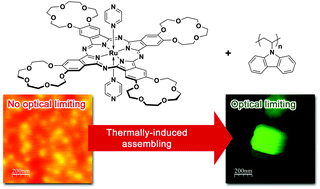The crucial role of self-assembly in nonlinear optical properties of polymeric composites based on crown-substituted ruthenium phthalocyaninate†
Abstract
Ruthenium(II) tetra-15-crown-5-phthalocyaninate with axially coordinated molecules of pyrazine [(15C5)4Pc]Ru(pyz)2 (1) was synthesized from a carbonyl complex [(15C5)4Pc]Ru(CO)(MeOH) (2), and the structure of the solvate complex (1)·6CHCl3 was revealed using the single crystal X-ray diffraction method. Analysis of the crystal packing showed that the weak intermolecular interactions, such as CH⋯π, CH⋯N, CH⋯O and CH⋯Cl, played an essential role in the formation of stable assemblies and their organization within the crystals. The interplay between the intramolecular axial coordinated pyrazine contacts and the weak intermolecular interactions of solvate molecules with crown-ether fragments provided the basis for rationalizing the observed self-assembly of molecules in solutions of tetrachloroethane and polymeric composites with polyvinylcarbazole. The self-assembly was investigated using UV-Vis spectroscopy, dynamic light scattering measurements, atomic force microscopy and transmission electron microscopy techniques. The formation of nanoparticles of complex (1) from a tetrachloroethane solution after three cycles of heating to 70 °C/cooling to 5 °C and two days storage was proved. Thin films (7 μm) of polymeric composites with polyvinylcarbazole prepared from a solution containing nanoparticles exhibited a nonlinear optical response measured by the Z-scan technique with application of femtosecond (1030 nm) and nanosecond (1064 nm) pulse lasers. The measured third-order susceptibility (χ(3)) of the polyvinylcarbazole composite with 4 wt% of complex (1) was equal to 1.94 × 10−10 esu, while the same composite prepared without the previously described special treatment had zero susceptibility. This result proves the essential role of self-assembly in future development of nonlinear optical materials.

- This article is part of the themed collection: Interdisciplinary Symposium on Materials Chemistry 2014


 Please wait while we load your content...
Please wait while we load your content...